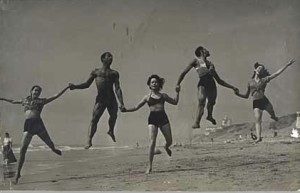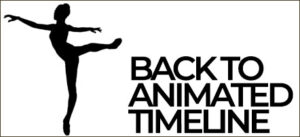1947
First Negro Classic Ballet Company debuts
The First Negro Classic Ballet company was established in 1946 by founder Joseph Rickard (1918-1994).
After Joseph Rickard witnessed an African American child being turned away from dance classes in Los Angeles, he established a school to train African Americans in classical ballet. He later founded the First Negro Classic Ballet. The company’s first recital was on October 19, 1946 in the Danish Auditorium on West 24th Street in Los Angeles; their first professional performance occurred on November 19, 1949 in Santa Barbara’s Lobero Theatre. They also performed in theaters such as the Assistance League Playhouse, the Philharmonic Auditorium (1950), and the Sartu Theater in Hollywood (1954), as well as going on tour. The company was said to be a “multiracial endeavor,” including three Latina dancers and a white dancer. Dancers with the company included Theodore Crum, Bernice Harrison, Graham Johnson, James Truitte (also danced with Lester Horton Dance Theater), Donald Stinson, Yvonne Miller, Gene Hill Sagan, Ardie Allison, Shirley Vargas, and Diane Gordon (the company’s one white dancer).
The company’s resident composer and pianist was Claudius Wilson, an African American, who was born in New Orleans and attended Dillard University. The company’s repertoire included: Cinderella (music by Claudius Wilson), Streetlight, Raisin’ Cane, Harlot’s House (music by Claudius Wilson), A Little China Figure (music by Camille Saint-Saens), Landscape/Southern Landscape, Variations Classiques (music by Bach), Trois Etudes de Danse (music by Chopin), Symphonic Etudes (music by Robert Schumann), Rondo Capriccioso (music by Felix Mendelssohn), Tales from the Vienna Woods (music by Johann Strauss).
Rickard and choreographer Edward Flemyng combined their companies, The First Negro Classic Ballet and Flemyng’s New York Negro Ballet, in 1956. Using original company members, Rickard’s choreography, and Wilson’s music, the new company performed on tour in the UK. The company folded when their main sponsor died, and the First Negro Classic Ballet disbanded in 1959. Company dancers went on to perform in films such as Finian’s Rainbow, An American in Paris, Showboat, and Carmen Jones.
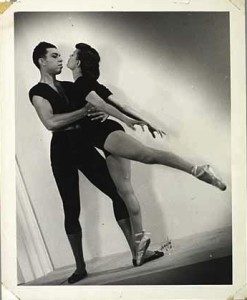

Sources:
Joan Myers Brown & the Audacious Hope of the Black Ballerina
UNC’s History of American Ballet (page no longer active)
A Ballet Troupe’s History Recaptured, Los Angeles Times
First Negro Classical [sic] Ballet at the Scala Theatre, photo
Vaulted Ambitions: Stories From Where We Were to How We Got Here, Stage Raw
Dance Moves: An African American Ballet Company in Postwar Los Angeles
Note: Rickard’s archives are located at the Huntington Library in San Marino, California.
Talley Beatty and Betty Nichols perform Lew Christensen’s Blackface with Balanchine’s Ballet Society
A minstrel-themed ballet, choreographed for Balanchine’s Ballet Society (which later would become The New York City Ballet), was performed by students from the School of American Ballet.
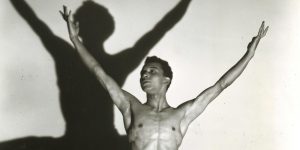
Talley Beatty (1920-1995), born in Shreveport, Louisiana, studied with Katherine Dunham as a child and was an original member of the Dunham Company for several years. He performed in the Broadway show Cabin in the Sky (1940) and in the films Carnival of Rhythm (1940) and Stormy Weather (1943). He also performed in Showboat (1946) and Inside USA (1948). Beatty studied at the School of American Ballet and performed Blackface (1947) with Ballet Society, an early Balanchine company. In the late 1940s and early 1950s, he taught at the Dunham School. During that period he also started the first of several dance companies. Beatty was one of the most notable African American choreographers. Among his many ballets are Road to Phoebe Snow (1959), Congo Tango Palace (1960), Caravanserai (1971), and The Stack Up (1983); he also choreographed for Broadway shows: a revival of House of Flowers (1968), Don’t Bother Me I Can’t Cope (1970), and Your Arms too Short to Box with God.
Sources:
“Obituaries- Talley Beatty” Dance Magazine, July 1995, pg 60.
Talley Beatty, 76, a Leader In Lyrical Jazz Choreography
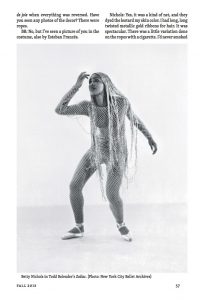
Betty Nichols was one of the first Black students at the School of American Ballet, and in 1946 she became one of the members of Balanchine’s Ballet Society, later touring with him in Europe. In addition to Blackface, she was also featured in Todd Bolender’s Zodiac.
In a 2013 interview, she said, “I started at the School of American Ballet, probably in 1943. I was the first black in the school. I knocked on the door and presented myself. I thought there was considerable surprise, but the door was opened, and that was it.”
Sources:
A Conversation with Betty Nichols, Ballet Review 2013
Other Happenings in 1947
American History
Jan 3: Proceedings of US Congress are televised for the first time.
Mar 12: The Truman Doctrine is announced to Congress by President Harry S. Truman.
Apr 30: The Boulder Dam is renamed in honor of Herbert Hoover.
Jun 5: Secretary of State George Marshall outlines the Marshall Plan.
Jun 11: Sugar rationing ends in US.
Oct 5: Harry Truman makes the first televised presidential address.
World History
Jan 31: The Communists take power in Poland.
Feb 10: In Paris, France, peace treaties are signed between World War II Allies and Italy, Hungary, Romania, Bulgaria, and Finland.
Apr: Discovery of the Dead Sea Scrolls becomes known.
May 3: The new Japanese constitution goes into effect.
May 22: The Cold War begins.
Jul 18: King George VI signs Indian Independence Act.
Aug 14: Pakistan gains independence from Great Britain.
Aug 31: The Communists seize power in Hungary.
Sept 30: Pakistan and Yemen join the United Nations.
Nov 20: Elizabeth II marries The Duke of Edinburgh in London.
Art & Science
Jan 10: Finian’s Rainbow opens in New York City.
Feb 12: Christian Dior introduces The “New Look” in women’s fashion.
Apr 6: The first Tony Awards occur.
May 2: Miracle on 34th Street is first shown in theaters.
May 22: The film Great Expectations opens in the United States.
Jun 25: Anne Frank’s The Diary of a Young Girl is published in Amsterdam.
Nov 6: Meet the Press makes its television debut.
Human & Civil Rights
Drafting of the Universal Declaration of Human Rights begins in early 1947.
Oct 23: NAACP petition on racism “An Appeal to the World” is presented to the UN.
Dec 25: Taiwan passes human rights laws.
Sports
Jan 18: Detroit Tigers sell baseball player Hank Greenberg to the Pirates.
Mar 9: US Ladies’ Figure Skating championship is won by Gretchen Merrill and Men’s is won by Richard Button.
Apr 1: Jackie Robinson signs a contract with the Brooklyn Dodgers.
Apr 15: Jackie Robinson becomes the first African American to play Major League Baseball since the 1880s.
Nov 27: Joe DiMaggio wins his third MVP.


